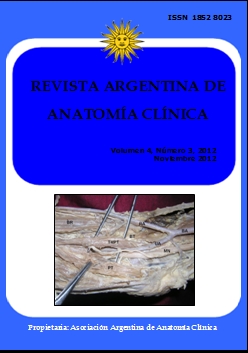A CASE REPORT OF QUADRANGULAR INCA BONE. Un caso de hueso cuadrangular inca.
DOI:
https://doi.org/10.31051/1852.8023.v4.n3.14034Keywords:
Human skull, interparietal bone, wormian bone, sutural bone, cráneo humano, hueso interparietal, huesos wormianos, hueso suturalAbstract
Los huesos wormianos son estructuras osificadas que se encuentran dentro de las suturas. En frecuencia que varían extensamente entre grupos étnicos diferentes hay más predominio entre mujeres. En el presente estudio reportamos el caso de un verdadero hueso cuadrangular interparietal o hueso inca en el cráneo humano adulto. Los huesos de wormian interparietal o los huesos epactal se diferencian de los huesos suturales sobre la base de su posición. Los huesos wormianos interparietales están localizados dentro de la región interparietal, mientras los huesos suturales son formados a partir de centros de osificación adicionales que pueden ocurrir en o cerca de las suturas. La osificación inadecuada de la región interparietal lleva a la formación de los huesos wormianos. Ellos también pueden estar relacionados con factores genéticos. El hueso interparietal es formado por la separación del segmento intermedio del plato lateral por la sutura occipital transversa, por lo tanto este hueso es formado por las placas intermedias y laterales que pueden ser únicas o múltiples. La localización de tales huesos está, sobre todo, en la parte central superior de la región interparietal. La ocurrencia de la variable del inca es rara es seres humanos. El conocimiento del hueso del inca puede ser útil a las clínicas, disciplinas de la neurocirugía, ortopedia, antropología, radiología y para los expertos forenses.
Wormian bones are ossified structures that are found within the sutures. Incidence of which varies widely among different ethnic groups with more prevalence among females. In the present study we hereby report a case of single true quadrangular interparietal or inca bone in adult human skull. Wormian interparietal bones or epactal bones differ from the sutural bones on the basis of their location. The wormian interparietal bones are located within the interparietal region, while the sutural bones are formed from additional ossification centers that can occur in or near the sutures. Inadequate ossification of the interparietal region leads to the formation of interparietal or wormian bones. They may also be linked with genetic factors. The interparietal bone is formed by the separation of the intermediate segment from the lateral plate by the transverse occipital suture, hence this bone is formed by the medial and lateral plates which may be either single or multiple. The location of such bones is mostly in the upper central part of the interparietal region. The occurrence of inca bone variation is rare in humans. Knowledge of inca bone in human skulls may be useful to clinicians, disciplines of neurosurgery, orthopaedics, anthropology, radiology and for forensic experts.
References
Bergman RA, Afifi AK, Miyauchi R. 1988. Skeletal systems: Cranium. Compendium of human anatomical variations. Baltimore: Urban and Schwarzenberg, 197–205.
Das S, Suri R, Kapur V. 2005. Anatomical observations on os inca and associated cranial deformities. Folia Morphol 64:118-21.
Duque CH, JoriSole FJ, Quintero JC, Pons ILC, López JL. 1998. Disostosis cleidocraneal Presentación de un caso. Rev. Neurol 27(159):838-41.
Glorieux FH. 2008. Osteogenesis imperfecta, best practice and research clinical rheumatol-ogy. http://en.wikipedia.org/wiki/Wormian_bones (accessed July, 2012).
Gordon S. 1963. The Book of Knowledge. 6th Ed, London: Waverlay Book Co Ltd, 161–166.
Hanihara T, Ishida H. 2001. Os incae: variation in frequency in major human population. J. Anat 198: 137-152.
Keith A. 1948. Human Embryology and Morphology. 6th Ed, London: Edward Arnold and Co, 223–224.
Marathe RR, Yogesh AS, Pandit SV, Joshi M, Trivedi GN. 2010. Inca – interparietal bones in neurocranium of human skulls in central India. J Neurosci Rural Pract 1: 14–16.
Mata JR, Mata FR, Ferreira TA. 2010. Analysis of Bone Variations of the Occipital Bone in Man. Int. J. Morphol 28(1): 243-248.
Saxena SK,Chowdhary DS, Jain SP.1986. Interparietal bones in Nigerian skulls. J Anat 144: 235–237.
Srivastava HC. 1992. Ossification of the membranous portion of the squamous part of the occipital bone in man. J Anat 180: 219–224.
Williams PL, Bannister LH, Berry MM, Collins P, Dyson M, Dussek JE. 1995. Gray’s Anatomy. 38th Ed, London: Churchill Livingstone, 583–606
Downloads
Published
Issue
Section
License
Authors retain copyright and grant the journal right of first publication with the work simultaneously licensed under a Creative Commons Attribution License that allows others to share the work with an acknowledgement of the work's authorship and initial publication in this journal. Use restricted to non commercial purposes.
Once the manuscript has been accepted for publications, authors will sign a Copyright Transfer Agreement to let the “Asociación Argentina de Anatomía Clínica” (Argentine Association of Clinical Anatomy) to edit, publish and disseminate the contribution.



